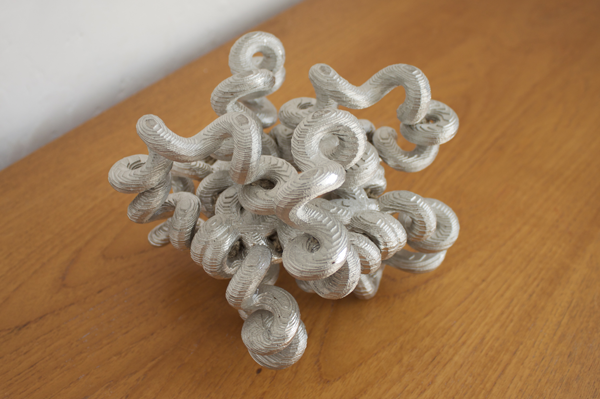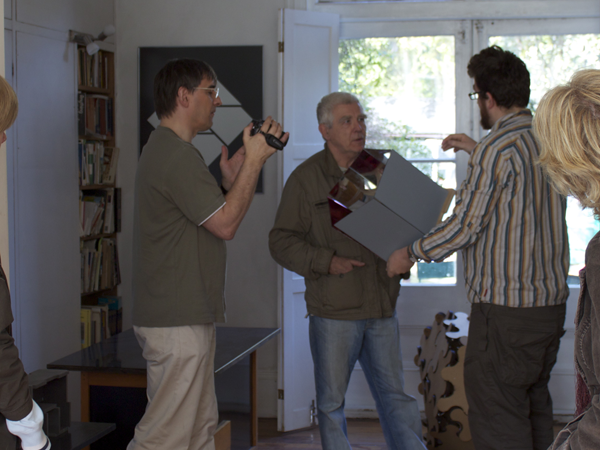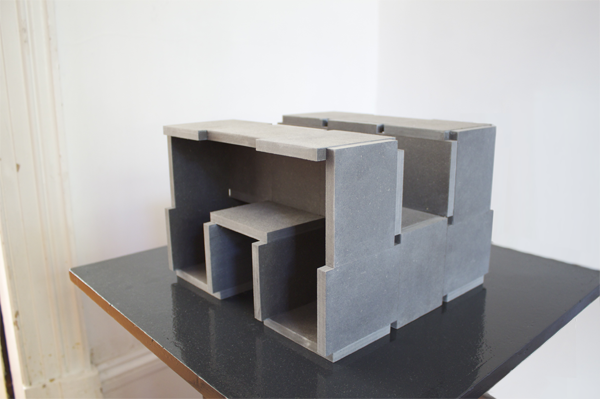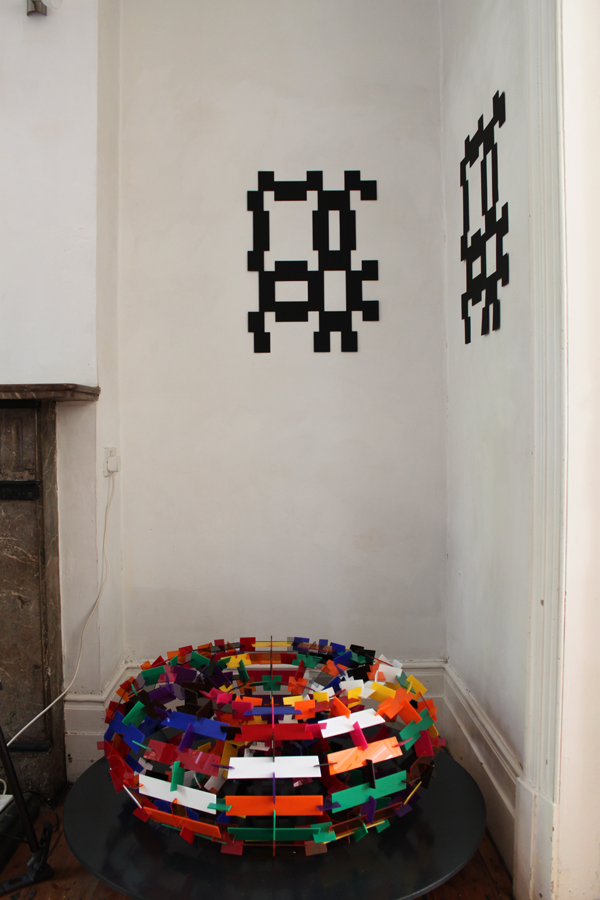The strange quest: Mathematics as Concrete Art
I have to confess that this post has not been an easy one to write. I wanted to express some ideas that are difficult to put into words. The central, rather playful, thesis is that pure mathematics itself is a branch of concrete art.
Let me begin with some easy facts. This month, I have had the great fortune to be able to take part in a studio exhibition with a group of constructive/concrete artists, including members of the systems group from the 1960’s. The exhibition was curated by Trevor Clarke in Peter Lowe’s studio. As a result I have had a chance to have some fascinating conversations with several artists, including Peter Lowe, Trevor Clarke and Jeffrey Steele.

Spirograph by Richard Grimes
One goal of the exhibition is to start dialogues between artists and technicians, in the spirit of the studio exhibitions that started the systems group in the 1950’s around Adrian Heath and Kenneth and Mary Martin. With that in mind I would like to give some of the ideas that emerged for me from the conversations.
Constructive and Concrete art arose from a natural conclusion of the process of abstraction. In the case of concrete art this is explicit and stated in Van Doesberg’s “Manifesto of Concrete Art”. Abstraction began by cutting away the figurative and symbolic content of artworks. As this program progresses more and more is cut away until, in a natural conclusion, one is left with nothing. Nothing is a fascinating concept. It is certainly not a trivial one, as we see with relatively late arrival of zero as a number. It does not, however, give a large space in which ideas can work. An empty canvas is an empty canvas and one ends up unable to tell the profound from the lazy. Concrete art emerges from this vacuum as the attempt to produce artworks that are not empty but have no figurative or symbolic meaning. It seems that this goal can be achieved in two distinct ways. One can either take the subconscious or irrational approach that leads to mysticism or the hyper-rational approach to create small works with their own logic. For obvious reasons I want to consider the second here.
This would seem to argue for a very subjective art, as we must not only consider different personal opinions about a piece, but the individual world that each piece inhabits. Constructivism is more ambitious than this. The idea of removing figure and symbol is not nihilism, but a desire to address raw or objective beauty. It is of course fully accepted that no such beauty exists. This leads to a strange quest, where the goal is known to be unobtainable.

Being interviewed by Peter Lowe about hyperbolic geometry.
I come into this from a different point of view. My art does not contain mathematics in order to have no content, but to communicate mathematics. The mathematics is precisely the symbolic meaning. Yet what is mathematics? My personal definition is that mathematics is any concept that can be considered without reference to the real world. I know that this is an intellectual land grab, but I favour overlapping disciplines anyway. Putting this definition together with the constructivist quest for beauty led to some interesting similarities. Let us consider a parallel history of the two topics.
In the late nineteenth century, while painting was starting the move to abstraction with the work of impressionists and others, mathematics was starting a re-examination of its axiomatic roots. Just as art became more abstract the concepts and fields of mathematics were being cut back to rest on top of the set theory of Cantor and Dedekind. By the 1930’s the impossibilities inherent in both quests were becoming apparent. A year after Van Doesberg published the “Manifesto of Concrete Art”, Göodel published “On formally undecidable propositions of Principia Mathematica and related systems”. This work showed that whatever axioms one considered (that allow arithmetic) there would always be holes, statements that the axioms did not say were true or false, and one could never be sure that there was not a contradiction a statement both true and false. This was the end of the dream of a perfect mathematical machine. Pure mathematics thus joined in the strange quest, seeking patterns and structure without the possibility of obtaining a final goal.

Work by Gary Woodley
In fact by the 1940’s the two subjects were recognising their similarities. Hardy published “A mathematician’s Apology” in 1940 that claimed that mathematics was an art form. With the humility that only a Cambridge academic can feel for his own place in the world he declared:
“A mathematician, like a painter or poet, is a maker of patterns. If his patterns are more permanent than theirs, it is because they are made with ideas.”
The quest of a mathematician, to Hardy, was to find beauty and truth, yet without defining exactly what he meant by either. This bears a striking similarity to the vision of constructivism that I described above. It is no surprise therefore that, perhaps unaware that mathematics had been declared an art, in 1949 Max Bill considered “The Mathematical Approach in Contemporary Art”.
I want to reverse Bill and consider that perhaps the mathematical structure itself, from gauge theory to groups, from motives to matrices from the games of Conway to the technical depth of Grothendieck, stopping on the way to take in the Hopf fibration and bifurcation, the Penrose tiling, and the 57-cell, is simply one giant work of concrete art put together by a cast of thousands. An edifice built with some logical consistency on the Zermelo-Frankael axioms and the fudge factor axiom of choice.
So here’s to everyone pursuing the strange quest in the belief that the universe has an inexhaustible supply of secrets, and there will always be new beauty to be found even in some of its simplest corners.

Works by Trevor Clarke and John Bremner
The show
A studio presentation linking a selection of historical and contemporary autonomous works with a focus on modular investigations including:
Alexander Rodchenko*
Anthony Hill
Dirk Verhaegen
Edmund Harriss
Freddy Van Parys
Gary Woodley
Getulio Alviani
Jean Spencer
John Bremner
Kenneth Martin
Mary Martin
Peter Lowe
Richard Grimes
Trevor Clarke
Curated by Trevor Clarke in response to an invitation from Peter Lowe to stage a studio exhibition.
*reconstructions

Lovely post Edmund, thanks. As it happens, I’ll be giving a talk on the subject of math and art to a general audience at a local lecture series in a couple of weeks. Your article definitely gives me some great ideas for topics to include. I like the two thrusts of mathematical-art-is-concrete-art and math-itself-is-concrete-art. I might want to bounce further ideas off of you later…
I don’t often take offence. I think I can count on fingers of both hands the number of times in my adult life that I’ve been offended by something.
I’m offended by you including Groethendieck and Gödel in the same post, paragraph, sentence or breath as, well, almost anyone else.
These are people that fundamentally changed our perspective on everything we took for granted. They advanced human knowledge by leaps and bounds almost unheard of until the beginning of the 20th century.
And here they’re put in the same category as some artists who realized things imbedded in R^3.
I’m sorry, but I’m going to need some stronger arguments for considering these people equals.
Gunni, I am very sorry to offend. I find it hard to dispute much of what you say, G\”odel especially I would agree did something that no one had done before. Rather than advancing human knowledge he started to map its potential limits. Groethendieck is also a giant, although personally I feel that the importance of his work has been slightly amplified by a cult of generality in mathematics that has never completely convinced me.
However I simply do not recognise your characterisation of concrete art as the realisation that things embed in R^3. Nor do I make any claims for equality. I think that the directions of achievements of Bill, Martin, Gödel and Groethendieck are so distinct that any comparison is not really possible. I know that I would feel the world was made a poorer place by the removal of any of them.
Dear Edmund,
I have a tendency to believe just the opposite in that constructivism has it’s aesthetic rooted in mathematics and very little of its beauty comes from the aesthetics of art. This does not discount the beauty of constructivism, the beauty of mathematics or the beauty in what you are doing.
Furthermore, constructivism could be the buzz word that the mathart community needs to gravitate to. Right now I see the mathart community struggling to make a stand however, I think it is due to no one writing the new manifesto. I think most mathart needs to separate itself from art and be what it is … like you said raw or objective beauty. Art is the expression of culture and mathematics transcends culture. Different things altogether.
Cheers,
Kaz
Kaz, I think you are right in why constructivism takes in mathematical ideas, but the reason for this comes straight from the aesthetics of art, not mathematics. Of course there are many intersections.
I find your other point troubling. Constructivism is an intellectually rigourous movement, not a buzz-word that can be picked up when convenient. There is much maths art that is not constructive art, Escher being a great example.
Dear Edmund
I was delighted to read your blog about the impossible quest. It felt as though you’d had fun writing it. It’s the most incisive writing about art I have read in a long while. I envy you mathematicians for being able to explore ideas most of us can’t even begin to dream about.
Paul Klee was into dreams and geometry and Max Bill attended his classes at the Bauhaus. Klee produced my favourite aphorisms about art , it goes something like this ‘Art is not to render the visible, but to render visible’. i.e. its not just about holding up a platonic mirror to nature.
For Max Bill and some of us, art is a search for pattern. And we are never going to find all the patterns even if we know some symmetries are finite. So it most probably is, like you say, an impossible quest both in maths and concrete art.
Dear Edmund,
You are correct for “buzz word” sounds pejorative and that was not my intent. Furthermore I made another mistake and said constructivism instead of Concrete art. Yet I doubt that Van Doesberg had any idea that he was pointing at pure mathematics. So are we going to say that the aesthetics of mathematics = Concrete art … if so … then so be it. Therefore the vismath movement is really a subset of concrete art and Escher’s work is polyaesthetic in the sense that it incorporates the aesthetics of Concrete art and Visual art.
Cheers,
Kaz
Pingback: Carnival of Mathematics #59 « The Number Warrior
Pingback: Socolar and Taylor’s aperiodic tile. « Maxwell’s Demon
Pingback: Don Quixote tilts at Zeta functions « Maxwell's Demon